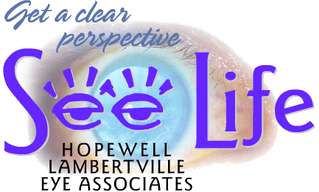FAQ: Dry Eyes
http://www.eanw.net/center-for- eye-comfort/dry- eye-disease/
http://kurwaeye.com/winter-woes- cold-weather- habits-lead-dry- eyes/
Dry Eye Disease: A multifactorial disease of the tears and ocular surface that results in symptoms of discomfort, visual disturbance, and tear film instability with potential damage to the ocular surface. It is accompanied by increased osmolarity of the tear film and inflammation of the ocular surface. Also known as keratoconjunctivitis sicca, dry eye syndrome, tear film insufficiency.
Translation: Dry eye is a complex, progressive disease that results from chronic damage to the parts of the eye that produce and support tears. The tears are responsible for providing protection, comfort, vision and maintenance for the eye surface. Typically, there is more than one initiating factor contributing to dryness of the eye. That is why a simple fix isn’t always available.
When should a person come in to see their optometrist for Dry Eye symptoms and when is it enough to take care of this problem yourself?
People usually know how to care for dry skin, but they may be unsure how to treat dry eyes, which can be equally or even more uncomfortable. In the winter months, with lower humidity, dry eye problems increase for some people.
There are various types of dry eye syndrome, and between 10 and 15 percent of people in the United States have dry eye problems "Many different factors can affect the tear film quality and amount, which leads to secondary changes in the eye and loss of vision,"
Causes of dry eyes include wind and sunlight; exposure to dirt and grit; decreased tear production as a person ages; eyelid abnormalities that affect the blink mechanism; and naturally and artificially dry environments. In addition, major causes of dry eyes are the side effects of medications or associated systemic (whole body) diseases such as rheumatoid arthritis or lupus. The list of medications that cause dry eyes is extensive and includes certain blood pressure medications (beta- blockers), antidepressants, heart anti-arrhythmia drugs and Parkinson's medications. However, people should not stop taking their medications despite dry eye problems.
What are the symptoms of dry eye?
Therefore it is recommended when an individual develops any form of symptoms that seem “out of the ordinary” it would be appropriate to present for an exam to determine the cause of the concern. Your doctor has to take a good history to elucidate the dry eye problem and determine whether it is related to an existing condition,"The symptoms can vary, both in frequency and severity. Patients can experience these symptoms constantly, off-and on, or not at all. Common symptoms include:
• Scratchy or gritty sensation
• Blurred Vision
• Increased sensitivity to light
• Aching, tired or sore eyes
• Itching and/or burning
• Redness
• Foreign body sensation - Grittiness or sandiness in the eyes
• Watery eyes
• Increased irritation from wind and smoke
• Contact lens discomfort
• Fluctuating vision throughout the day
• Heavy or sticky feeling in the eyes
WHAT ARE ALTERNATIVE TREATMENTS FOR MGD AND EVAPORATIVE DRY EYE?
Talk with your doctor about the alternative treatments that are right for you. Possible alternative treatments for MGD (Meibomian Gland Dysfunction) and evaporative dry eye include
• UVA protecting eyewear (Therablue Lenses)
• Lid hygiene – cleansing with natural based products. (Avenova)
• Increased utilization of Omega 3 – 6 Essential oils (HydraEyes or Omega Advance)
• Manual expression of your eyelid glands by your doctor. (Mibo Thermflo System)
• Warm compress therapy and eyelid hygiene using scrubs or massage. (Bruder Mask)
• Topical prescription medications such as Restasis. Xiidra, Doxycycline…
• Over-the- counter tear replacements and lubricants for dry eye.
• Punctal plugs made of silicone or collagen inserted in the tear ducts or lacriserts
• Cauterization (sealing) of the opening of the tear duct in the eye.
Could I be doing things to make my dry eyes worse?
•“Get the Red Out” drops like Visine or Rohto. These medicated drops do not address the underlying
symptom of dryness. Rather, drops like Visine work by constricting the blood vessels in the eyes (thus
making the eyes appear less red). This action results in a rebound effect of redness and further dries out
the surface of the eyes.
• Taking an oral antihistamine for itchy eyes during allergy season. Oral antihistamines can cause increased tear evaporation by changing the tear film composition, such as mucusproducing cells. Switching to an allergy eye drop will treat your allergy symptoms without drying out the eyes.
• Poorly cleaning contact lenses. Poor lens hygiene includes: not replacing the solution nightly, not cleaning the case, and using cleaning solution that is not compatible with your particular contact lens material. Contact lenses are a reservoir for harboring bacteria on the eye if your lenses are poorly cleaned, the lenses will likely cause more irritation.
• Extending contact lens wear past advised replacement schedule. Contact lenses go through rigorous testing before passing the guidelines provided by the FDA. Studies show that wearing contacts past their advised wearing schedule decreases the oxygen permeability of contact lenses.
• Extensive computer use. Excessive Ultraviolet light A from digital technology and the sun have proven to advance ocular pathology such as dry eye; cataracts, macular degeneration.
• Poor hydration.
What if I don’t treat my dry eye? Will it get worse?
Dry eye is a chronic, progressive disease that affects the surface of the eye. Without treatments, the symptoms may ebb and flow, but there is likely progressive damage occurring to the front surface of your eye. If left untreated, dry eyes can become dangerous. Excessive dryness can scar the cornea, impairing vision and damaging the tissues. Significant dryness can lead to greater chance of infection, breakdown of the corneal barriers and perforation of the cornea.




